Brazil have won eight of the nine Copa América Femenina championships, making them the most successful South American team. Although they advanced to the final in 2007 and the semi-finals in 1999, they are yet to win the FIFA Women’s World Cup trophy. They are currently ranked in the ninth position in the FIFA world rankings.
Brazil won the 2022 Copa América Femenina, defeating Colombia 1-0, to claim the title of South American champions and earn a spot in the World Cup. They won all seven games while scoring 20 goals and maintaining a spotless record with seven clean sheets, demonstrating their superiority in the area.
The team is led by Swedish coach Pia Sundhage, who has a proven track record of success at international level. She guided the USA to two Olympic gold medals in 2008 and 2012 and a second place at the 2011 World Cup and also took Sweden to a silver medal at the 2016 Olympics. She took over Brazil in 2019 and has been working on improving their defensive solidity and tactical flexibility.
This tactical analysis will look at the Brazil team in greater detail, breaking down who will likely be in their squad, their tactics in attack, defence, and transition, and will discuss a key player to look out for. The scout report will also indicate what expectations there should be for them and a prediction of how far they can realistically progress.
All the individual stats presented below include all the completions the player has participated in this season but the team stats concern the last 11 games to have a more realistic view of the team’s dynamic.
Predicted starting XI
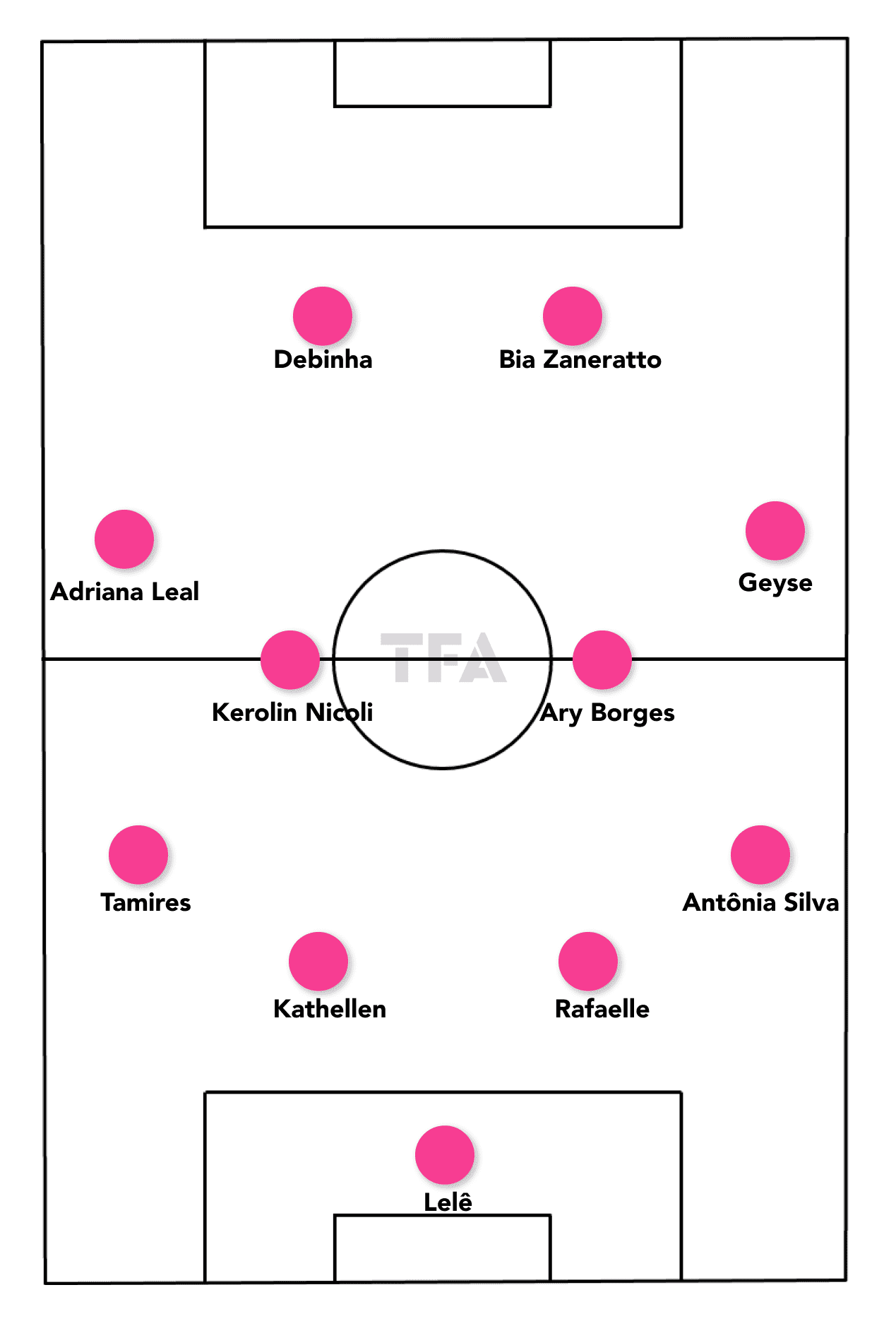
Sundhage has been experimenting with different formations and players since she took over in 2019, attempting to discover the optimal balance between experience and youth, as well as between defence and attack. The last 14 games have demonstrated that she has settled on a traditional 4-4-2 flat formation. Additionally, she has mixed a possession-oriented, dynamic style of play with verticality, which complements the technical skills and creativity of the Brazilian players.
The 4–4–2 provides a structured way of playing, with players having clear instructions and responsibilities during the game. Brazil has a mix of experienced veterans and promising youngsters in their squad.
In goal, Corinthians goalkeeper Letícia Izidoro, also known as Lelê, is likely to be Brazil’s number one choice. She started the last two games against Germany and in the CONMEBOL/UEFA Women’s Finalissima 2022 against England. In her last 31 games across all competitions, she has an impressive average of 81% saves, providing a sense of security for Brazil’s defence.
Additionally, she has kept 14 clean sheets and has an average of 0.73 expected goals against, making her an unquestionably excellent option for the starting goalkeeper position. However, there will be strong competition between her and Lorena Leite, Grêmio’s goalkeeper, who won the Golden Glove and was voted the best goalkeeper of the 2022 Copa América Femenina.
The defensive line has three guaranteed positions and one spot where two players will compete for a starting place in the starting line-up. Rafaelle Souza, the 31-year-old centre-back, is a leader both on and off the pitch and undoubtedly will be one of the two starting centre-backs. She has been a reliable performer for her country and Arsenal throughout this season. She possesses height, strength, and composure, excelling in winning aerial duels and intercepting passes.
The other two certainties for the back four are the left and right full-backs. The 35-year-old experienced Corinthians player Tamires has over 130 appearances for her country. On the right side, Antônia Silva should be considered a sure thing since she has started for Brazil in all the games she was available during the last season.
There may be some rotation in the position of partner Rafaelle as the second centre-back. Two players, 27-year-old Real Madrid player Kathellen and 20-year-old Lauren have an equal chance of being in the starting XI. Kathellen provides experience, while Lauren brings aggressiveness, increases the speed of the back four and provides much more security in aerial duels.
For the flanks, two players who excel in one-on-one situations have an advantage in securing a spot in the starting XI. Adriana Leal from Orlando Pride and Barcelona‘s star player, Geyse, are the most likely options.
Regarding the two central midfielders, the coach prefers to use one player with a more attacking mindset and another player with a defensive one, controlling the tempo from deep characteristics. The most common duo that played for the majority of the last games consisted of the two 23-year-olds — Kerolin and Ary Borges. Kerolin will have the freedom to move to higher positions on the pitch or out to the sides, while Borges will maintain a more central position.
An alternative for these two positions is to use the 30-year-old Luana Bertolucci as one of the two midfielders. On that occasion, Borges will move to the right flank and most probably Geyse will be one of the two forwards.
For the two centre-forwards positions, in case Geyse will play as a right winger, will be Palmeiras’ Bia Zaneratto and Kansas City forward Debinha.
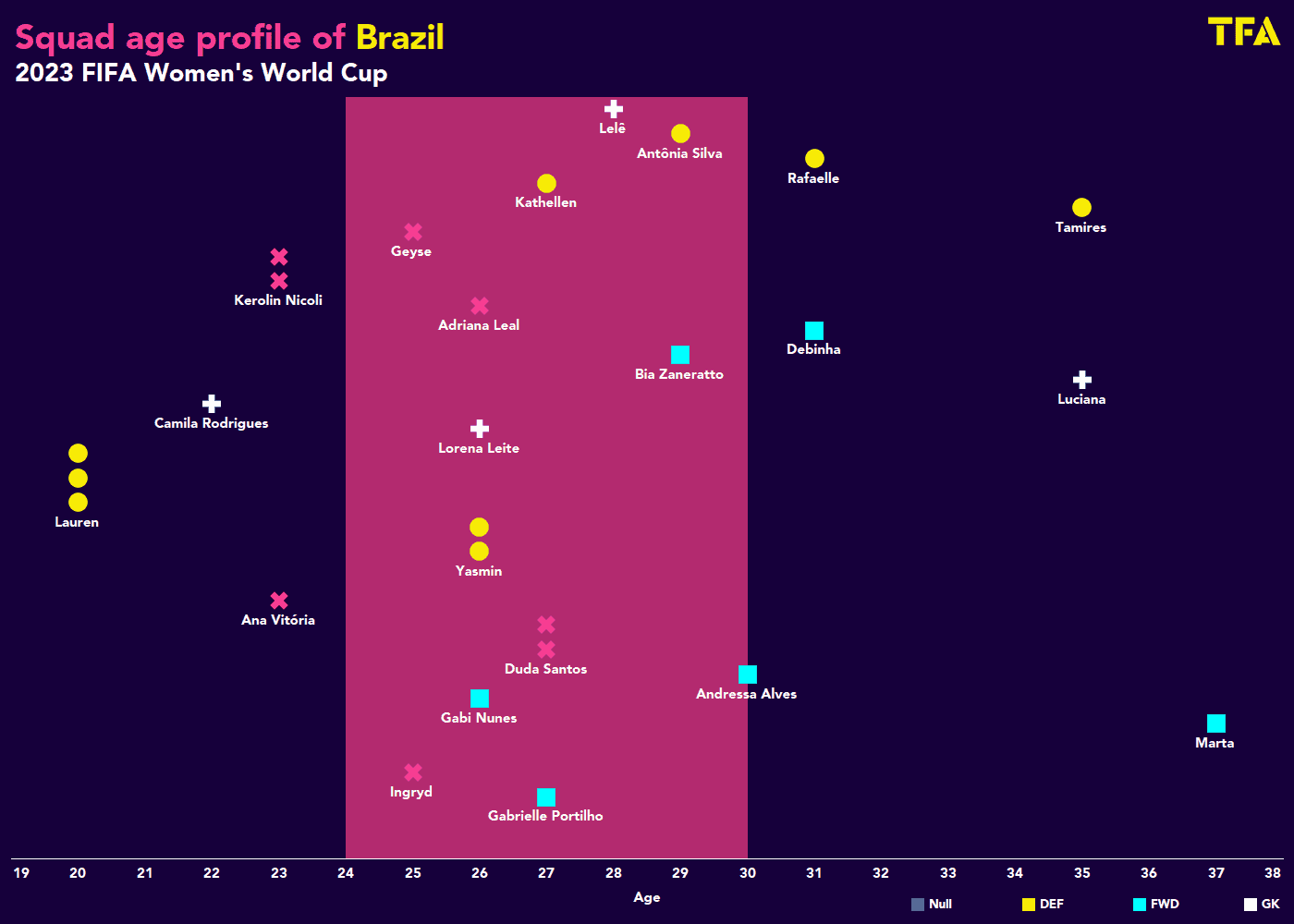
The age range chart shows that Brazil has a mixture of experienced and young players who provide talent and maturity. The youngest players who are considered as potential starting XI are not below 23, meaning that they have enough experience from top-level football to cope with the pressure that a presence in a World Cup creates.
Attacking Phase
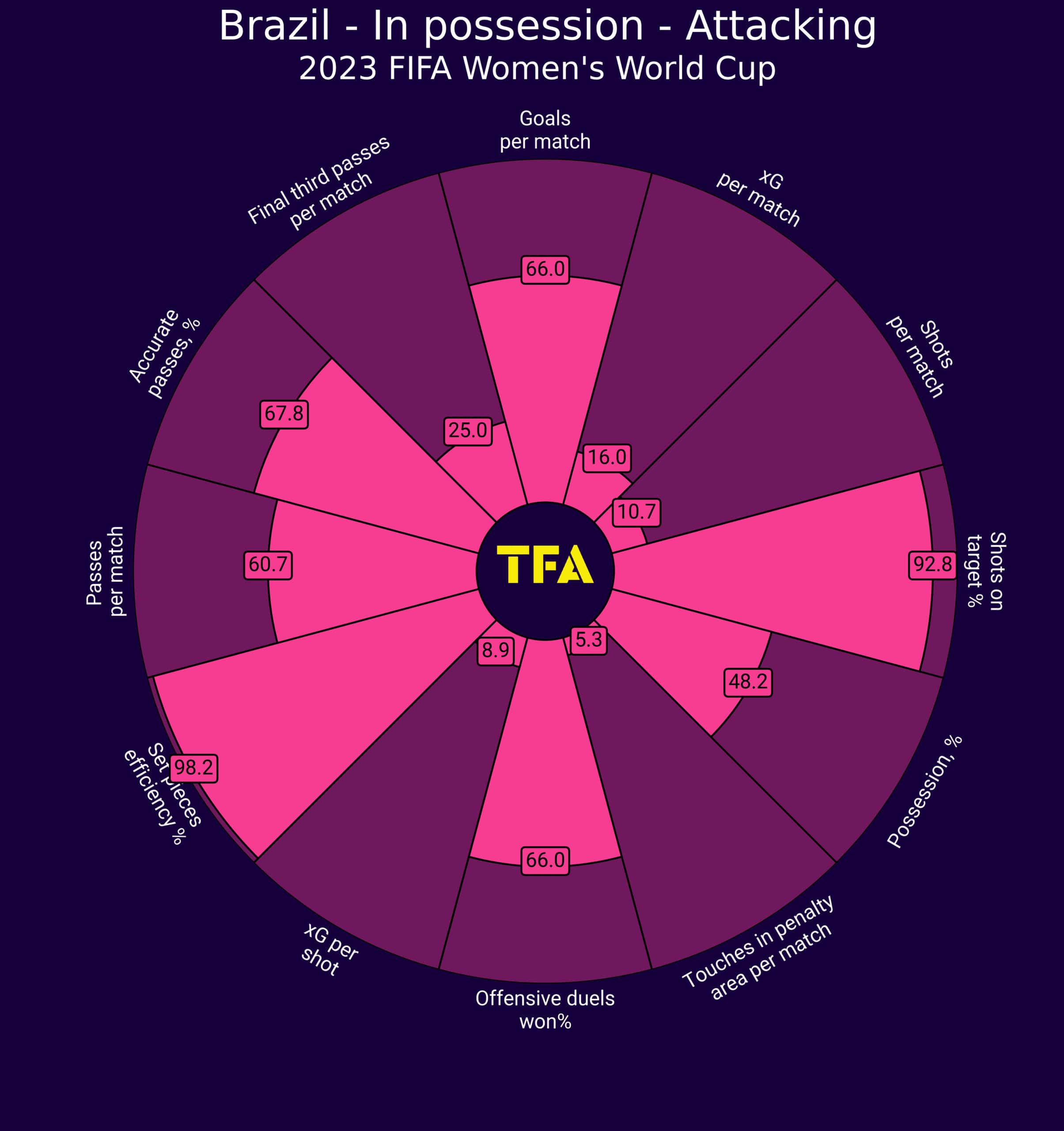
What characterises Brazil in the attacking phase is their verticality, their skill in 1v1 situations, and their tendency to play with the ball. Brazil often targets their inside wingers to exploit isolated situations. As a result, their ball possession averages around the middle (49.43% in the last 11 games). They have a mixed attacking style that includes moments and areas of high possession, as well as moments where they prefer to take more risky vertical passes.
As the chart shows, Brazil is among the top teams in shots on target % and set pieces efficiency. This is largely due to their skilled and talented players who excel in individual actions that result in finishing actions.
However, the low expected goals (xG) per match metric contradicts the shots on target. This can be attributed to the characteristics of Brazil’s forwards and wide players, as well as the team’s style of play. The forwards are more mobile and tend to rely less on being a target in the box. The team prefers not to rely on crossing to bring the ball into the box, which explains the low number of touches inside the penalty area and passes in the final third. In the opponent’s half, many of the actions are driven by the individual quality of the players.
Additionally to these situations, Kerolin’s presence in the midfield with her tremendous dribbling skills offers an option to break through the centre and attack with the ball without the need to find a correct through pass for the attackers.
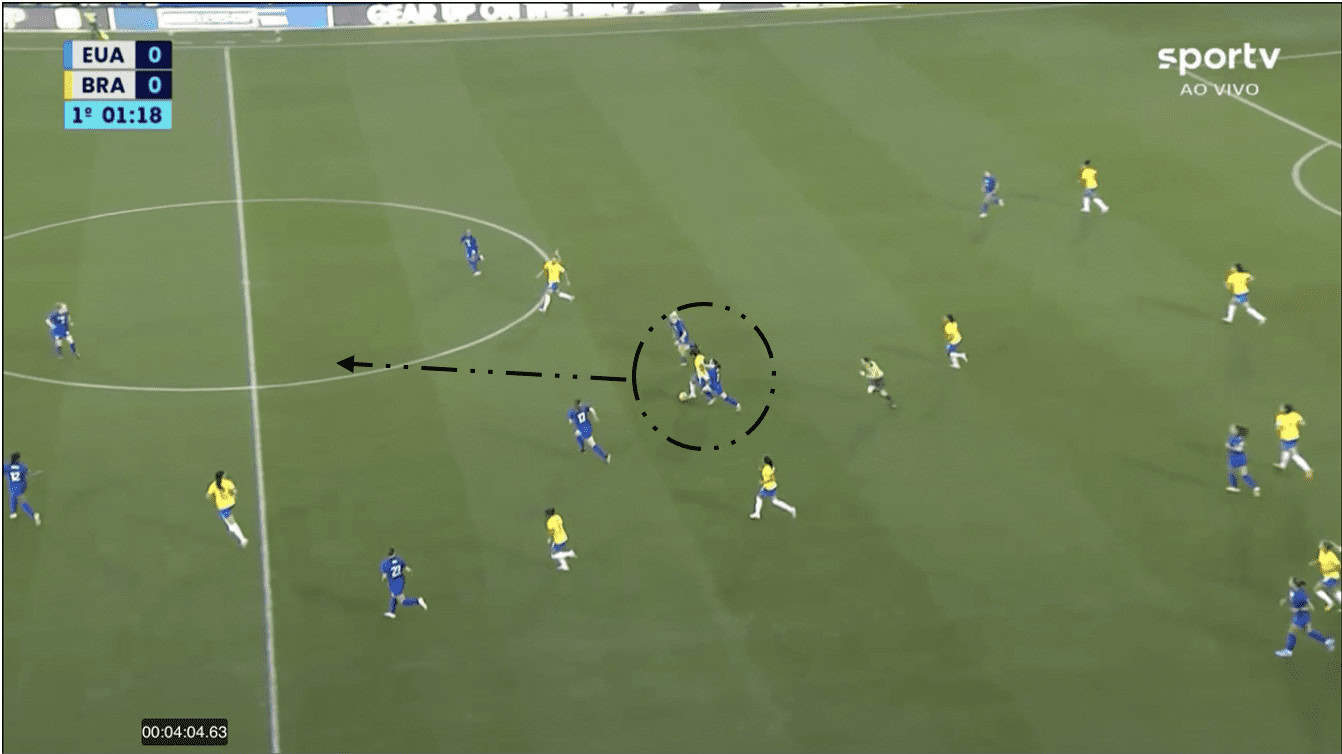
The backline moves the ball across the four of them. The priority is to pass the ball between the lines and then transfer it to the flanks or look for individual actions.
Positionally related, Tamires offers a lot of flexibility in Brazil’s attacking play. She is an attack-minded full-back, and her positioning higher up the pitch provides an opportunity for the left winger to cut inside, creating numerical overloads on the flanks and posing defensive challenges for the opponents.
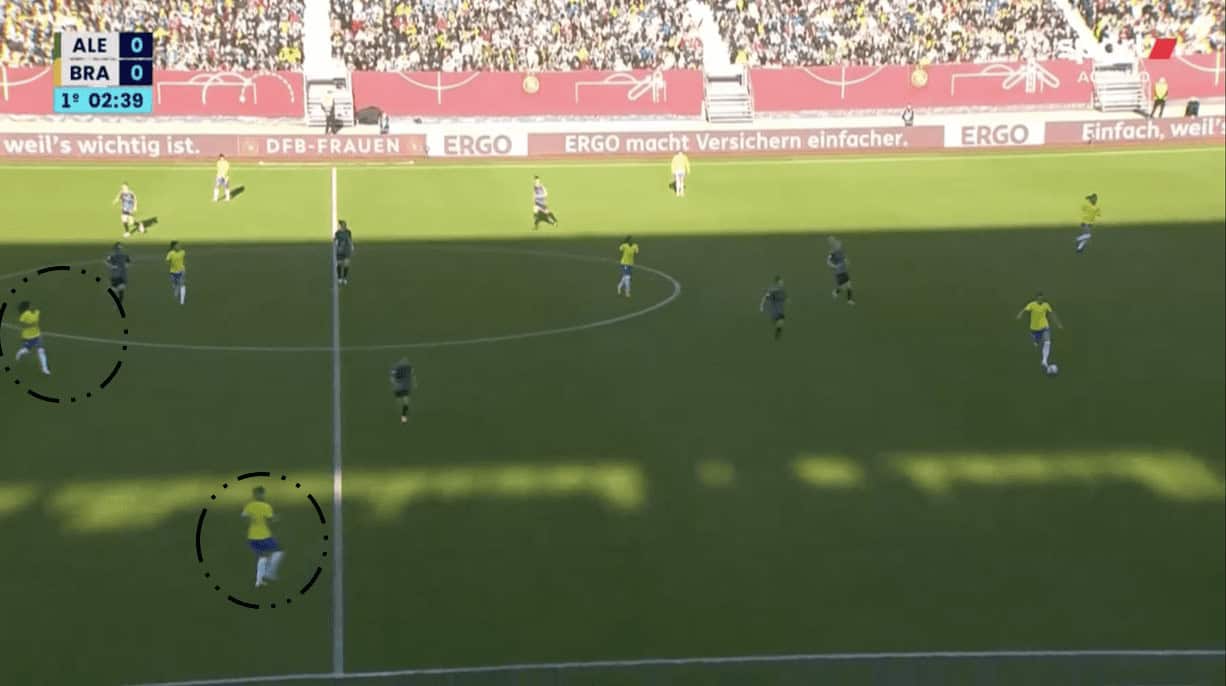
Brazil has the advantage regarding attacking duels, thus they focus their game on creating and exploiting such situations. Crossing actions are not one of the main principles in Brazil’s game. The average of just 11.09 crosses per 90 minutes is indicative of this. The games in which Brazil needed to cross more were against teams that preferred to defend with a very low and compact block, making crossing the easiest way to get the ball into the box. For example, in a friendly match against Norway that took place on 7th November 2022, Brazil completed 21 crosses with a success rate of 47.62%. Out of these 21 crosses, nine were delivered by Tamires, the player from Corinthians, who completed a total of 11 crosses in the last six international games, the most among any of her teammates.
Verticality is a highly notable characteristic of Brazil’s women’s national team. The pass accuracy rate of 80.71% is relatively low due to their inclination towards prioritising forward play. In the last 11 games, out of an average of 395.81 passes, approximately 34% were directed forward.
Another significant data regarding Brazil’s attacking game is the average 3.43 passes per possession in these 11 games which exemplifies their preference for ball retention until an opportunity to advance arises.
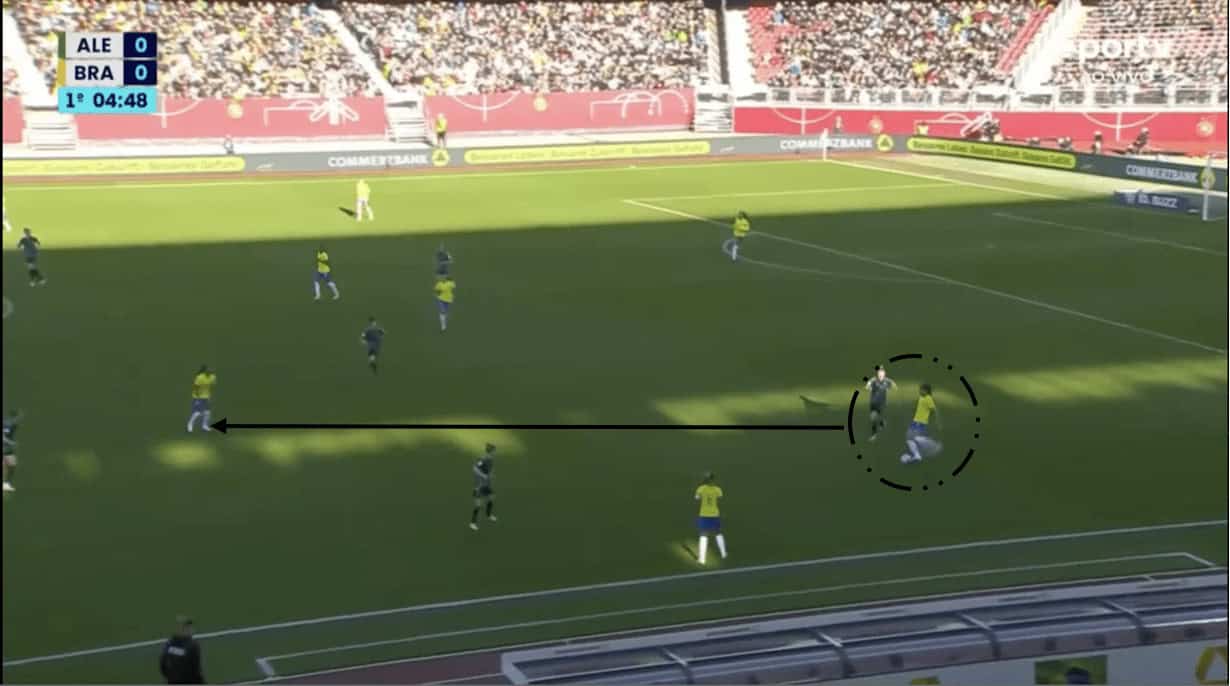
What is mentioned above contradicts the low success rate of their passes. The explanation is straightforward. Despite attempting to complete three/four passes in each possession, it is common for them to skip the easy pass to the second line and opt for a direct pass to the third line, thereby limiting the chances of successful completion.
The regular positioning of the wide players in the half-spaces instead of the touchline indicates that Brazil intend to advance the ball vertically beyond the midfield line. From that position, they aim to exploit attacking duels and utilise their forward players’ attacking skills to create goalscoring opportunities.

Also, the wide player’s positioning in the inside spaces offers another two attacking options. First, it allows the fast wingers to have a shorter distance to cover toward the goal in case of a long ball and a run behind the opponent’s back line. Secondly, it creates spaces for the full-backs to push up and force the opposition midfield and backline to stretch, creating gaps in the centre of the pitch.
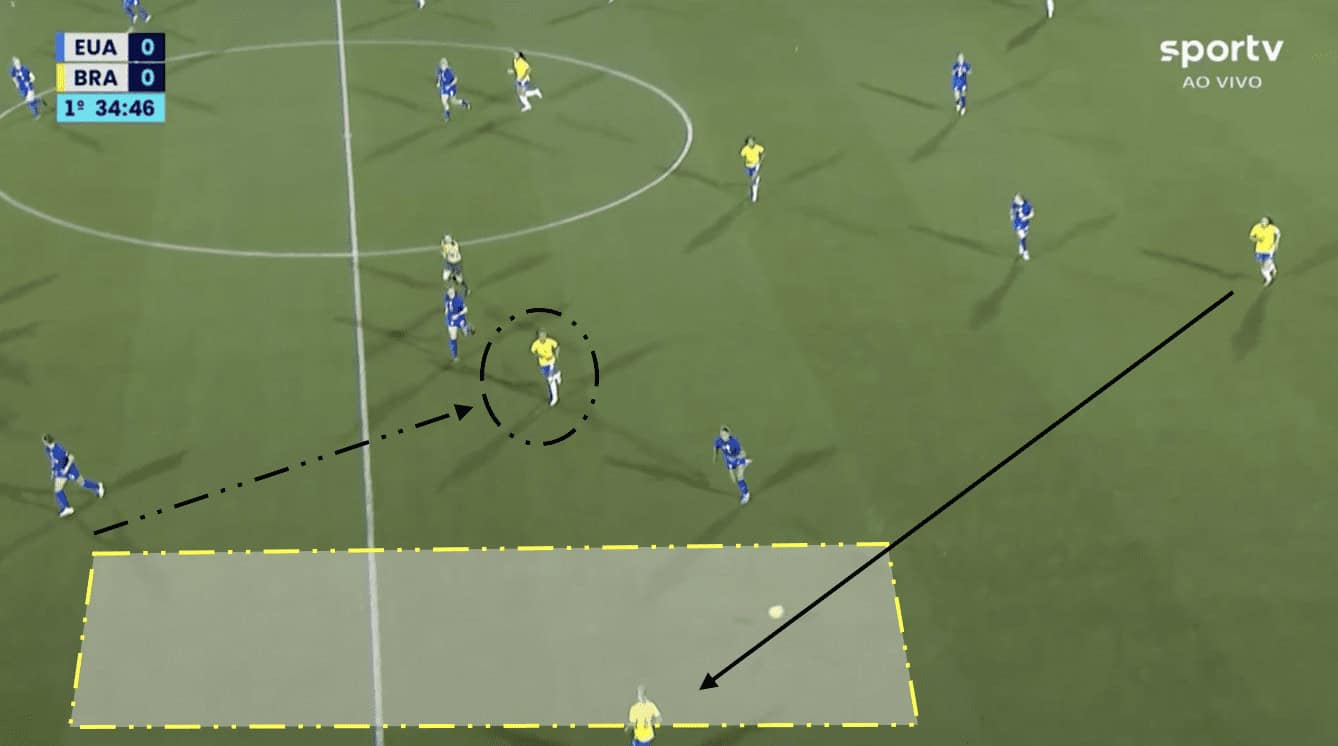
The game against the USA on the 23rd of February showed some of the challenges they have during the build-up from the back against a very aggressive high press. While Brazil has an average of 16.95 losses in low areas, against the high-pressing team of the USA they had 27.
Defensive Phase

In the defensive phase, Brazil implements a clear zonal defending behaviour but with high-pressing characteristics, especially from the two forwards and the four midfielders. With a PPDA of 8.26, it’s clear that the team aims to identify the correct triggers to start their pressing from a medium block position and move it until the final third.
In the opposition’s static build-up, the players of Brazil are positioned in a 2-4 formation. On certain occasions, one of the two forwards assumes a slightly deeper position strategically to redirect the play toward the preferred side.
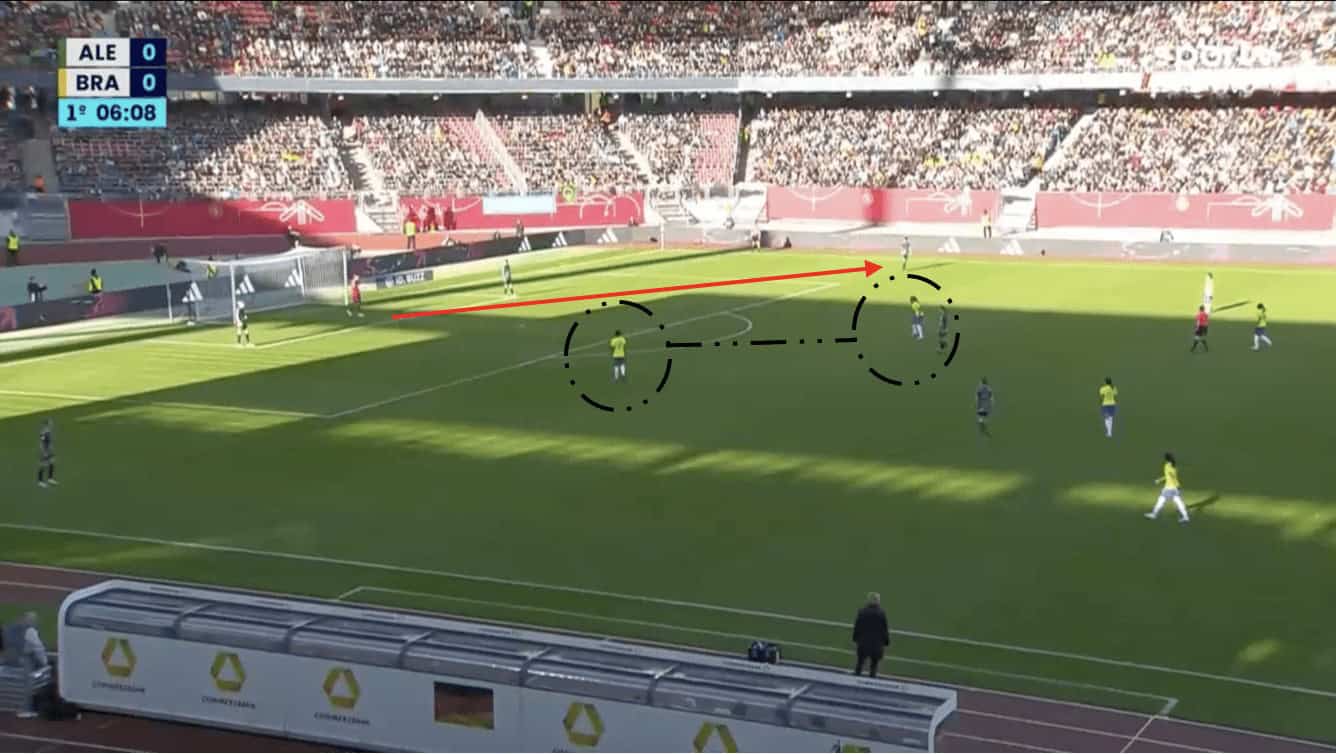
During the opponent’s possession phase, Brazil is primarily positioned in a medium to high block. From these initial positions, they anticipate specific pressing triggers, which serve as signals to initiate increased pressure. One of their major advantages in these scenarios is the synchronised collective movements of the front two and the middle four players in a cohesive manner. The objective is to channel the ball towards one side, restrict nearby passing options, and regain possession or compel the opponents to play long balls.
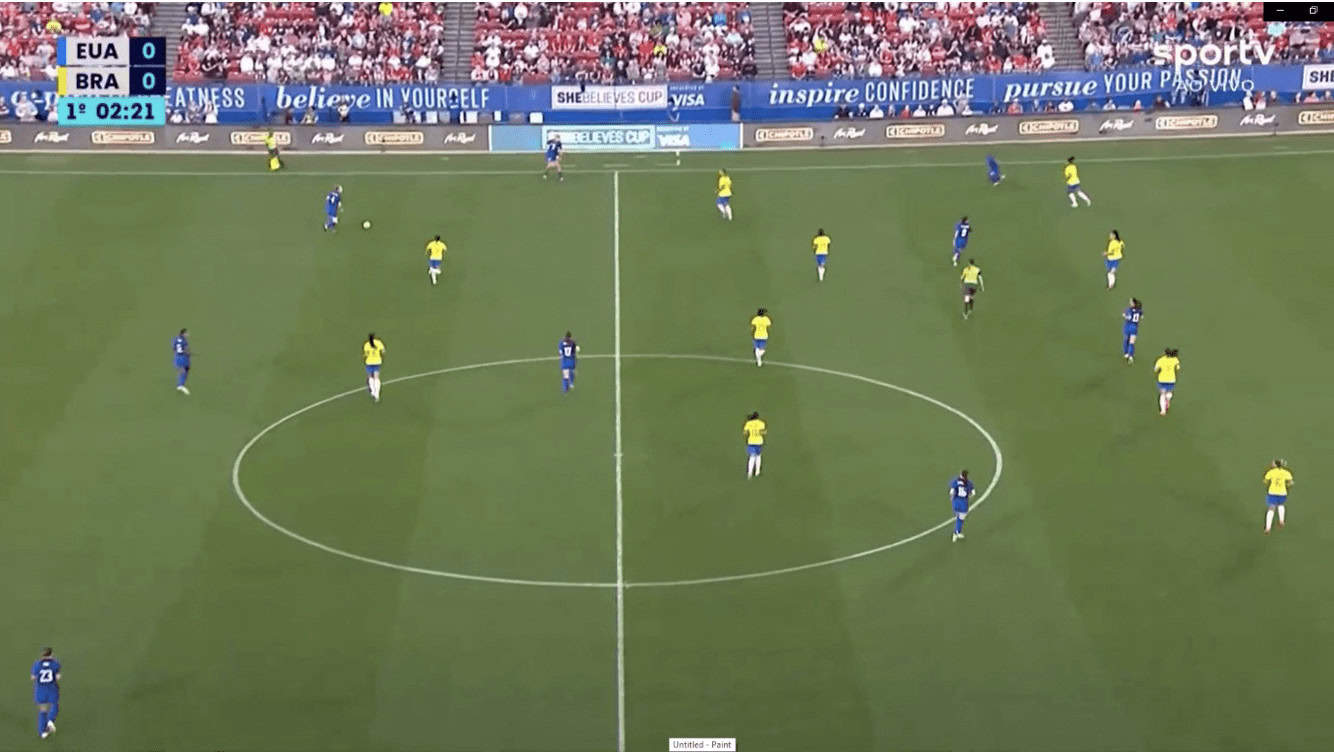
The two forwards typically allow one or two passes between the centre-backs and the goalkeeper. This is one of the pressing triggers. At that point, they apply pressure to the ball. Depending on the position of Brazil’s central midfielders and their distance to apply pressure on the opponent’s number six, the weak-side centre-forward will either jump to the second centre-back or drop to cover any passes to the centre. The usual scenario is to create a 2v2 situation against the opponent’s centre-backs, or even a 2v3 against a backline of three. The spaces behind are covered by the midfielders who have pushed up.
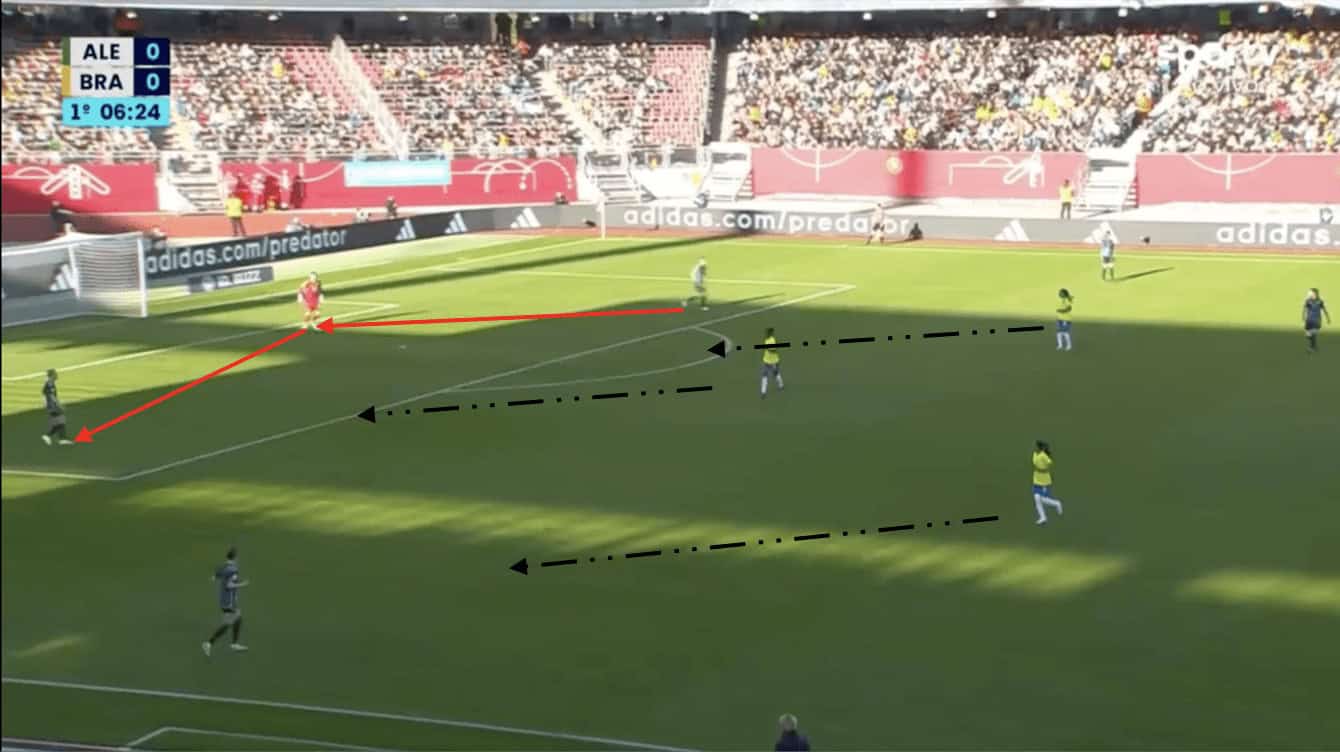
Another pressing trigger is any backward pass. This is the signal for stepping in front and collectively moving the defending line higher up the pitch.
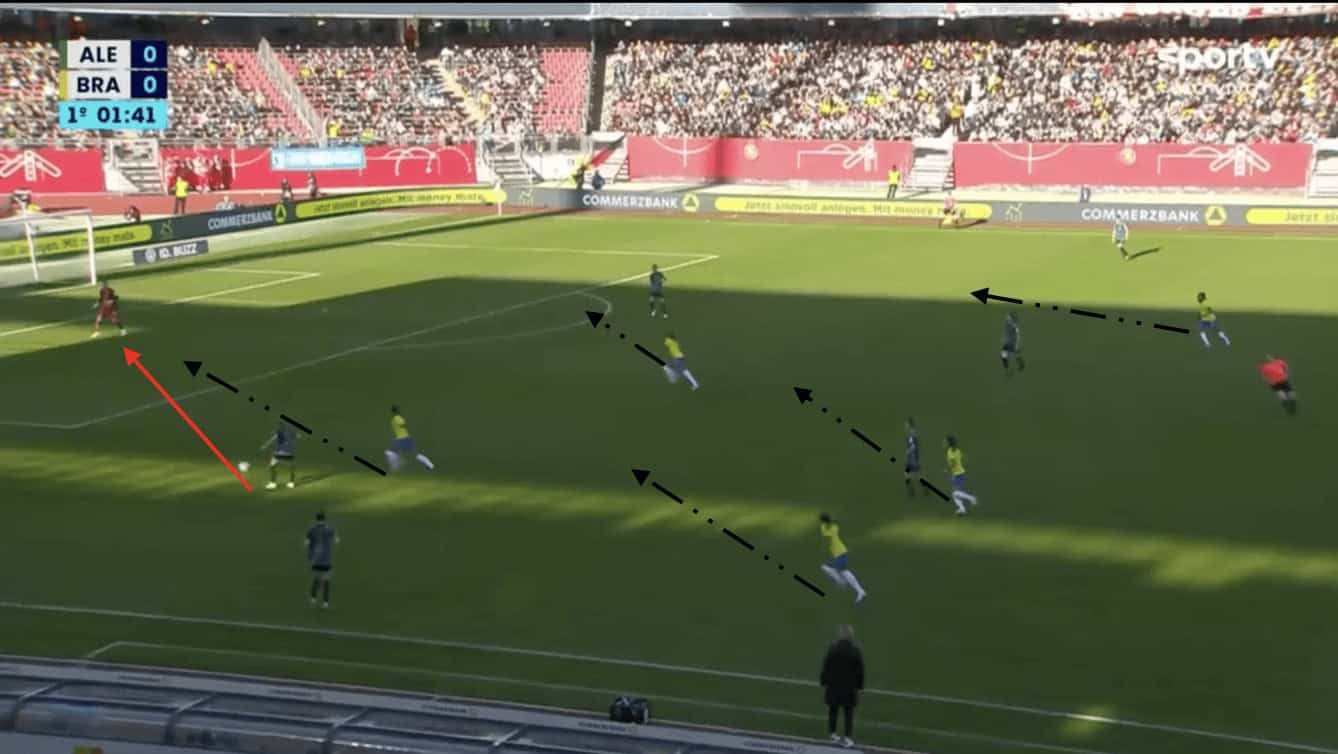
The above method of defence has its pros and cons. The advantages are that when facing the majority of teams, the aggressive pressing helps in recovering any balls played to the opponent’s central midfielders or forces them to resort to long balls. However, directing balls, whether in the air or on the ground, towards Brazil’s backline can be a potentially dangerous scenario due to the continuous duels that the defenders have to engage in. With a collective aerial duel success rate of only 43% and an overall defensive duel success rate of 66%, it is evident that they face challenges in that area. When up against strong teams with highly skilled attackers, these success rates drop even further to 33% and 63%, respectively.
The other weakness that Brazil exhibits in the defensive phase, resulting from their aggressive pressing approach, are the gaps left between the defensive line and the midfield line. High-quality teams with possession-oriented gameplay are likely to exploit these spaces. In the last 11 games, Brazil’s opponents have had an average of 27.27 passes to the final third, but against the USA, Germany, and England, the average number was 34.66. In the match against England (ranked fourth in the Women’s World Rankings), Brazil conceded a total of 42 passes in the final third.
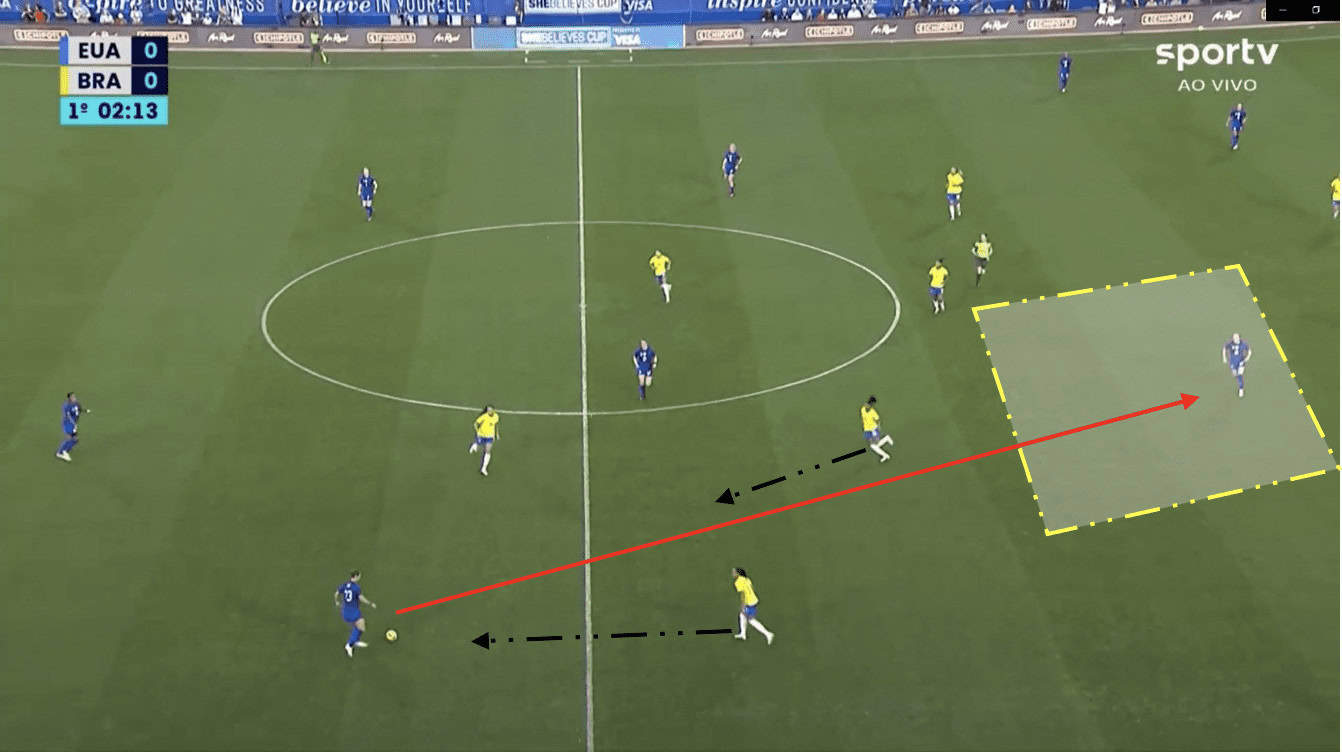
Transitions
During the negative transition, Brazil’s players have different instructions to follow. The central midfielders, the two forwards and the wide midfielders (if the ball is near them) will try to apply immediate pressure while the back line and weak side’s winger will recover back to their starting positions and quickly create a compact narrow block to protect the central spaces.
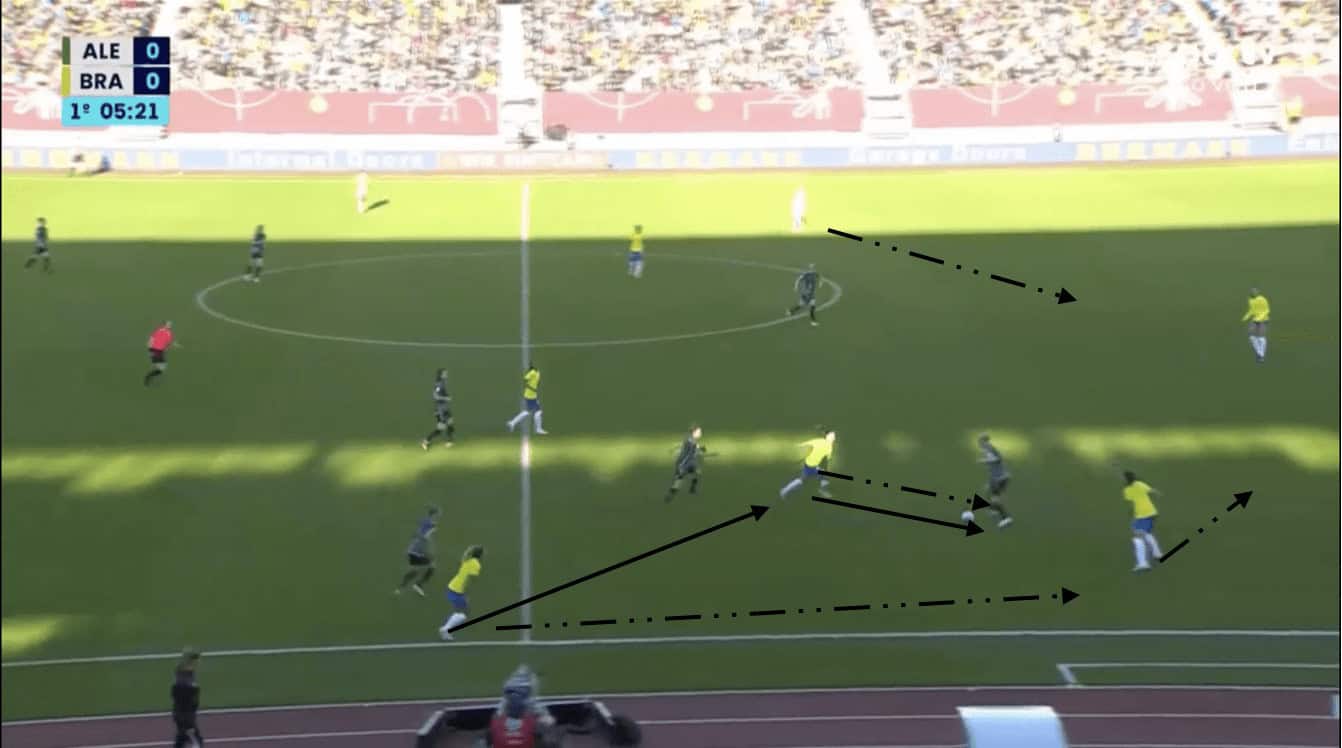
The central midfielders are key players in defensive transitions. Their position on the pitch enables them to apply aggressive pressure. However, against quality teams, there is always a risk of leaving gaps behind for the opponents to exploit, especially when the pressing is not timed correctly. Brazil has recorded 88 ball recoveries per 90 minutes in their last 11 games, with 60.6% of them occurring in the middle and high areas.
For the positive transition, depending on where the ball will be regained, the players always have in mind to quickly move the ball forward either with a pass or by driving with the ball and capitalise on the two centre-forwards. The two wide midfielders begin to move forward to exploit the vacant space. On average, the team executes 2.45 counterattacks. If we exclude the friendly game against the formidable Germany, in the previous six matches, Brazil had an average of four transition opportunities per game, with 25% of them resulting in a shot.
Defenders
The back-four line with Rafaelle, Kathellen, Silva, and Tamires has an average of 63.5% aerial win rate. The central-back Kathellen has the lowest percentage with just 43.9% and is a clear weak point where the opponents can hurt Brazil. For that point, in games where the opponents tend to use more long balls, Lauren with an aerial win rate of 63.6% will most probably be used.
The weak link in the back-four in terms of defending duels is the left full-back Tamires, who has a mere 58.8% winning ratio. Brazil should devise a strategic plan to double-team Tamires and consistently provide defensive cover. Utilising a more defensively-minded player like Luana Bertolucci as a left central midfielder could be a viable solution, especially when facing teams with skilled one-on-one wingers. On the other hand, Silva excels in her defensive responsibilities, offering greater balance in defensive transitions and ensuring solidity at the back. The remaining defenders boast an impressive win rate, surpassing 75% for each of them.
In the attacking phase, Rafaelle is the key player for playing out from the back and transferring the ball to the second or third line. Even though her average passes success percentage is relatively low (86.75%) considering her position, she is the defender with the highest number of passes per game and the best passing accuracy. None of the defenders has more than 90% successful passes. This happens mainly due to Brazil’s style of play which is characterised by verticality and the effort to find as much as possible the most advanced free players on the pitch.
Midfielders
Adriana is an outstanding dribbler who excels in isolated situations and against highly defensive and compact teams. With an average of 5.4 dribbles per 90 minutes in all competitions and a 50% success rate, she is a constant threat to any opponent as a left winger. Since her debut in 2017, she has scored 12 goals in 44 cups.
On the other side, Geyse shares a similar profile. She is known for her explosive acceleration, agility and dribbling skills, as well as her flair and unpredictability. She averages 5.58 dribbles per 90 minutes with a 54% success rate. Both players exhibit more characteristics of forwards rather than traditional wingers, which explains their limited time spent on the sidelines. Her numbers for the national team are six goals in 41 games so far. This season, she has scored six goals in 20 games with Barcelona in the Spanish league.
Kerolin, the 23-year-old attacking midfielder who plays for Palmeiras, will most probably be one of the leading stars in the effort of Brazil to win the title. She is a fast and agile dribbler who can create chances for herself and finish them with great accuracy. With an average of eight dribbles per game and a 50% success rate, she will be the main point of reference of the team to break opponent’s pressure through the centre, especially against teams who defend in a very narrow and compact block with no spaces to pass the ball through. In her last 14 appearances in all competitions, she scored six goals with a total of 4.24 XG, thus her efficiency regarding the goal is out of discussion.
Luana Bertolucci, the 28-year-old Corinthians defensive midfielder, joined the national team in 2019 and has become a regular starter in the midfield. Luana is a strong and intelligent player who provides balance in Brazil’s attack-minded team. She primarily occupies deeper positions to facilitate safe ball circulation and, more importantly, to stop the opponent’s counterattacks.
With 8.5 recoveries per 90 minutes and an overall success rate of 69% in defensive duels, Luana is considered the most valuable defensive player in the midfield for Brazil. Unfortunately for her, the low passing accuracy success rate (70.88%) in all competitions and the 62.28% of correct forward passes do not allow her to become a regular starter player since she cannot help Brazil equally in defence and offence, especially against lower quality teams where her team will have the ball for the majority of the time.
Ary Borges, the 23-year-old defensive midfielder for Racing Louisville FC, is a versatile and dynamic player who excels in various positions and roles in the midfield. She demonstrates equal efficiency and flair in defending, distributing, and attacking. This season, in all competitions, she has an average winning rate of 61.7% in defensive duels and makes 6.45 recoveries per game. In the attacking phase, her average of 35.54 passes per game indicates that she is not heavily involved in possession play for her teams (either her club or Brazil), but her 86.7% pass accuracy ensures safe ball circulation. She is an ideal partner for Kerolin, providing balance in the midfield line.
Attackers
Brazil are known to have a burning passion for football and for producing some of the best attackers in the world, such as Marta, Cristiane, and Formiga. However, in recent years, a new generation of talented forwards has emerged to lead the team.
Debinha is a versatile and creative player who can play as a winger, a second striker, or an attacking midfielder. She is one of the established stars of Brazilian football, having won the MVP award in the 2019 NWSL Championship Game and twice the MVP in NWSL Challenge Cup (2021 and 2022). She currently plays for Kansas City in the National Women’s Soccer League. With North Carolina Courage she won two championships and one golden boot. Debinha is a fast and skillful player, who can create chances and score goals. With the national team, she has 130 appearances and 58 goals.
Bia Zaneratto is a powerful and speedy striker who can play on either flank or as a centre-forward. She made her debut for Brazil in 2012 and has scored 37 goals in 109 caps for the national team. She currently plays for Palmeiras in the Brazilian league, where she has scored 15 goals in 22 games this season. Zaneratto is known for her physical strength, pace and aerial prowess, as well as her clinical finishing and movement off the ball.
Last but not least, even though she will mostly be coming from the bench, one of the most iconic names in women’s football is Marta. Marta is widely regarded as one of the greatest players of all time, having won six FIFA World Player of the Year awards, more than any other player, male or female. She is also the all-time leading scorer in World Cup history, with 17 goals and also the top scorer for Brazil in all international competitions with 115 goals in 174 appearances.
Key Player
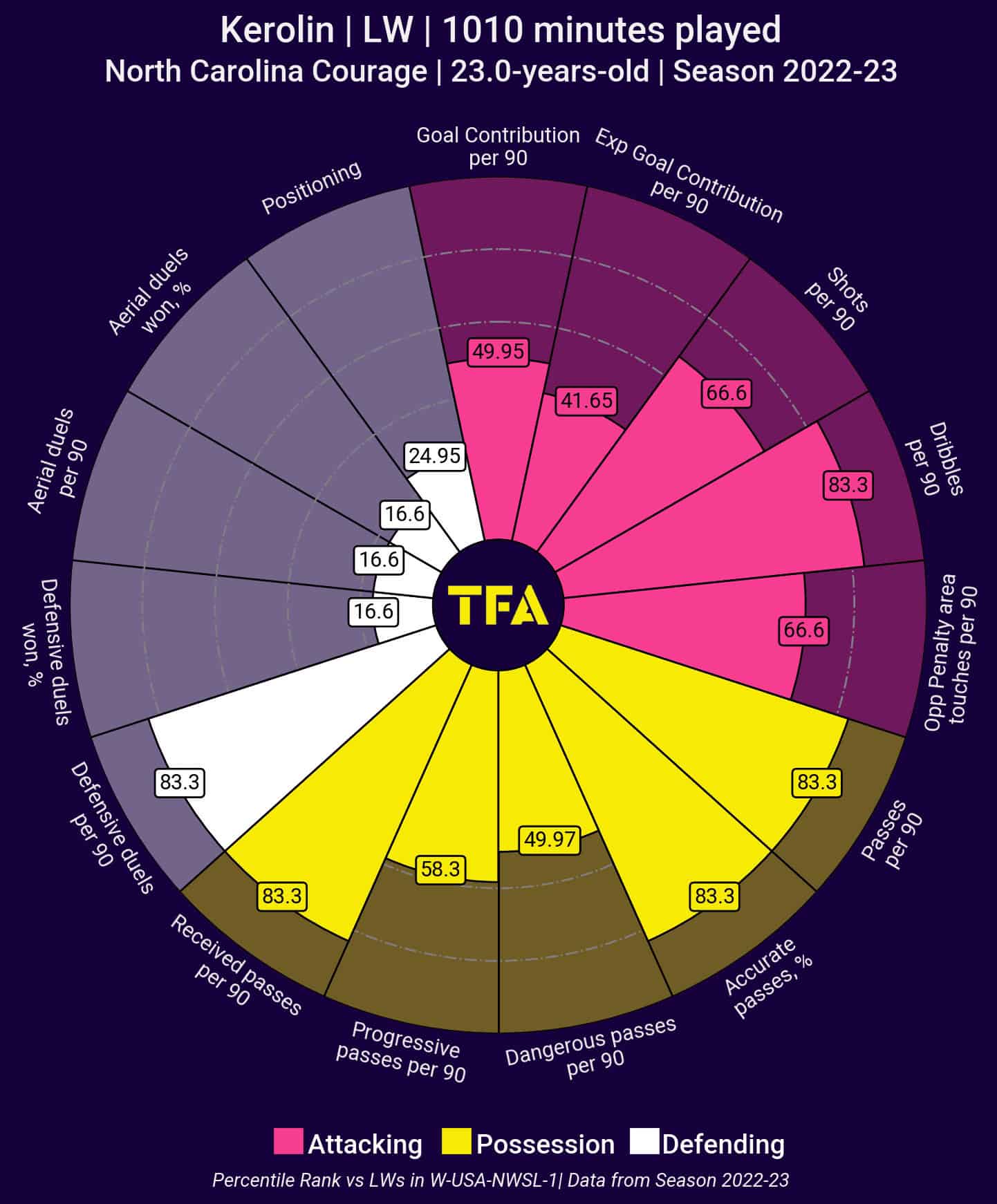
Even though Brazil possess some of the most talented players in world football, one of the key players for Brazil in their effort to win their first World Cup trophy will be Kerolin. The young talented and versatile player will be the point of reference for Brazil’s attacking actions.
She can play as a forward, midfielder, or even winger under special circumstances, depending on the needs of the team and the coach’s strategy. She boasts excellent technical skills, speed, vision, and creativity, making her a threat to any opponent.
The chart undeniably demonstrates that Kerolin is an exceptional player in all individual attacking actions. She will most likely be the most dangerous player for Brazil. In terms of dribbles, successful dribbles, and shooting, she will be among the top players of the tournament. Additionally, she will excel in creating dangerous opportunities for her teammates with key passes, assists or second assists.
She can adapt to different situations and challenges, showcasing the ability to score goals, create chances, defend effectively and lead by example. Despite being only 23 years old, she has demonstrated great maturity and confidence in her previous appearances for the national team.
Tournament Prediction
Brazil have been drawn into Group E alongside France, Jamaica, and Panama. They will play their opening match against Jamaica on July 24th at Hindmarsh Stadium. They are expected to advance to the knockout stages with relative ease, as the only strong contender in the group is France. They possess a talented and experienced squad capable of competing with any team in their group, thanks to their attacking style of play.
If they qualify for the next round, they will face one of the teams from Group H, Germany’s group. Their recent victory over Germany demonstrated their ability to overcome this challenge and progress further in the tournament. In the quarter-finals, Brazil will need to showcase a team that is capable of defending well. The strongest opponents they are likely to face, assuming no surprises, are Canada and England. Brazil have recently faced both teams and, once again, demonstrated their ability to defeat them.
Considering the World Cup draw and the team’s analysis of strengths and weaknesses, Brazil have a high probability of reaching at least the quarter-finals. From there, with a focus on defence and their undeniable offensive quality, they stand a serious chance of reaching the semi-finals of the tournament.

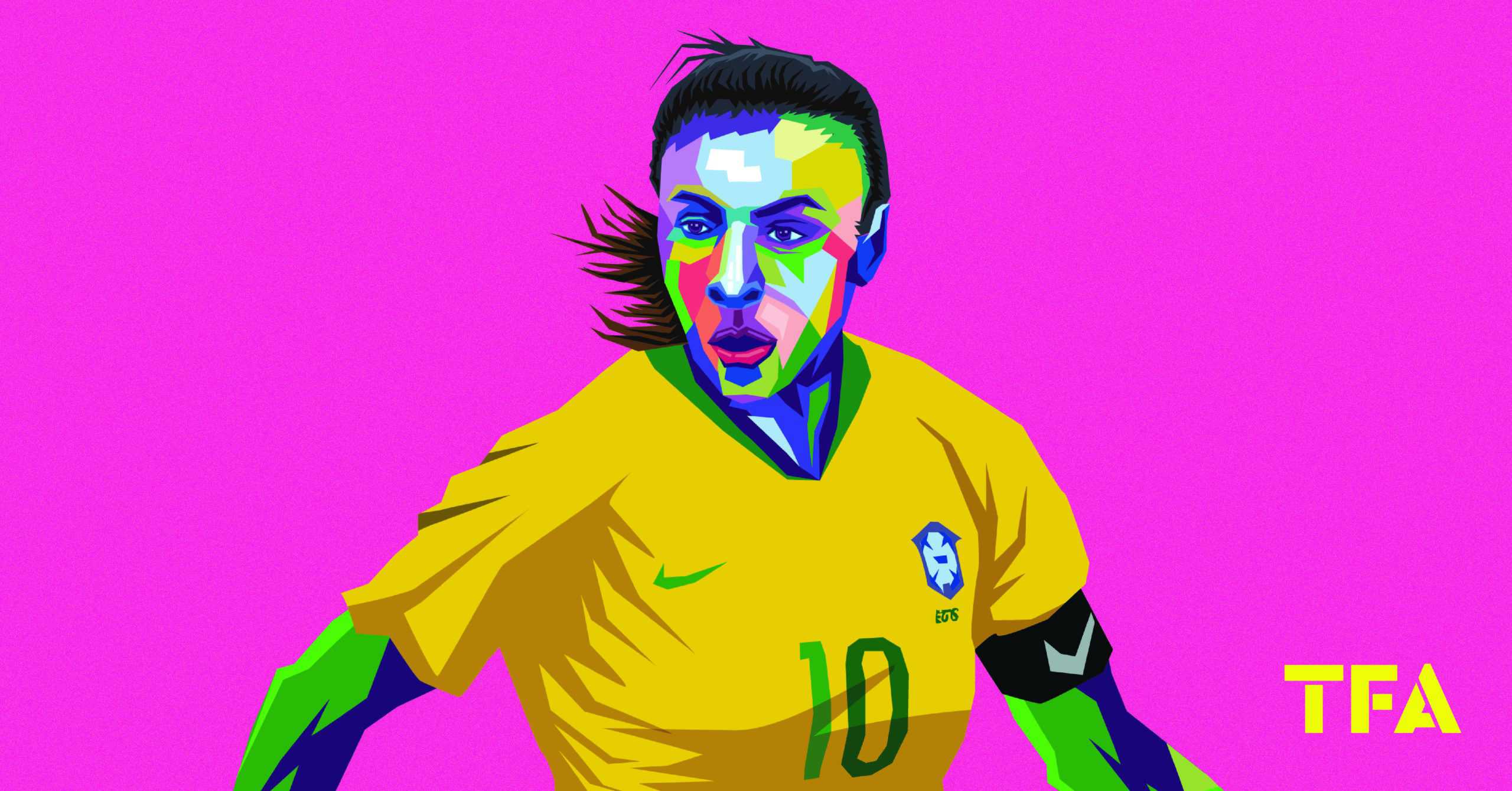



Comments